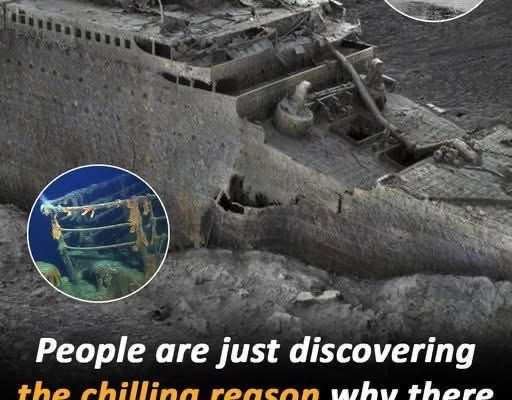The Haunting Mystery of the Titanic’s Missing Victims
More than a century after it vanished beneath the waves, the story of the RMS Titanic continues to fascinate and haunt us.
On April 15, 1912, during its maiden voyage from Southampton to New York, the “unsinkable” luxury liner struck an iceberg and sank, claiming the lives of over 1,500 passengers and crew.
But amid the heartbreak and horror, one unsettling mystery still lingers: Why were so few bodies found at the wreck site, despite the massive loss of life?
Unearthing the Titanic’s Final Resting Place
For decades, explorers and historians searched the Atlantic’s depths for any trace of the Titanic. The breakthrough finally came on September 1, 1985, when the wreck was discovered more than 12,000 feet below the ocean’s surface.
While the general area of the sinking was known, the exact location remained elusive for years. The vastness of the ocean and the limitations of deep-sea technology made the search incredibly difficult.
It was deep-sea explorer Robert Ballard who led the successful mission. Using a revolutionary strategy of tracking a trail of debris—an approach he had refined while locating the lost nuclear submarine Scorpion—Ballard spent eight days scanning the ocean floor before discovering the Titanic roughly 400 miles off the coast of Newfoundland, Canada.

A Promise of Respect — and the Haunting Silence of the Deep
When Robert Ballard first laid eyes on the Titanic’s remains resting silently on the ocean floor, it was a moment of awe and reverence.
“We made a promise to never take anything from that ship, and to treat it with great respect,” he told CBS News—an oath that reflected the deep emotional weight of the discovery.
Despite that initial vow, numerous expeditions have since returned to the wreck, retrieving hundreds of haunting artifacts: ornate dinnerware, fragments of furniture, and intimate personal items left behind by those who never escaped the icy waters. These relics, many recovered during the first major salvage mission in 1987, offer chilling glimpses into the final moments aboard the ill-fated ship. Yet even then, it became evident that time had not been kind—many artifacts were already badly degraded by decades under the crushing pressure and corrosive saltwater.
The Vanishing Dead: A Mystery Beneath the Waves
One of the most disturbing aspects of the wreck site is not what was found—but what wasn’t.
The Titanic was discovered torn in two, with the bow section astonishingly well-preserved, its ghostly interiors still visible after more than 70 years beneath the sea. Surrounding the wreck lay a vast debris field, stretching five miles long and three miles wide—thousands of scattered objects from the ship’s final plunge.
But amid the wreckage, one heartbreaking detail stood out: there were no bodies.
The total absence of human remains has long puzzled historians, scientists, and explorers. How could over 1,500 souls perish in a single night—yet leave no visible trace at the bottom of the ocean?

Traces of Life, Echoes of Death
Though bodies are largely absent from the Titanic wreck, small, sorrowful reminders remain. Scattered across the ocean floor, explorers have found shoes, boots, and personal belongings—silent indicators that someone once lay there.
Of the 337 bodies recovered in the days following the disaster, 119 were buried at sea. The remaining 209 were brought to Halifax, Nova Scotia, where many rest in marked graves. But the vast majority of the over 1,500 victims were never found—or if they were, their remains vanished with time.
James Cameron, the Oscar-winning director of Titanic and one of the most frequent visitors to the wreck site, shared a chilling truth in a 2012 interview with The New York Times:
“I’ve seen zero human remains,” he said. “We’ve seen clothing. We’ve seen pairs of shoes, which would strongly suggest there was a body there at one point. But we’ve never seen any human remains.”
Where Did the Bodies Go?
The answer lies not in myth, but in science—and in the harsh reality of the deep ocean.
Resting over 12,000 feet beneath the surface, the Titanic sits in a realm of nearly freezing temperatures, crushing pressure, and complete darkness. These extreme conditions shape what does—and doesn’t—survive.
In the immediate aftermath of the sinking, bodies that weren’t recovered likely floated for a time, buoyed by life jackets. Eventually, they would have sunk—some still strapped into deck chairs, others surrounded by scattered possessions—descending into an ecosystem hungry for organic material.
Down in the deep, sea creatures and bacteria made quick work of soft tissue. But the absence of bones raised even more questions.
The Ocean That Consumes Everything
According to Robert Ballard, the man who discovered the Titanic wreck, the lack of skeletal remains is due to the unique chemistry of the ocean at that depth. The seawater below 12,000 feet is under-saturated in calcium carbonate, a key mineral that makes up human bones.
Without this mineral support, bones slowly dissolve—literally vanishing over time after the body’s soft tissues have been devoured. In this way, the ocean itself erases all but the most durable remnants: shoes, leather, metal.
Ballard compared the Titanic site to the Black Sea, where conditions are starkly different. In the anoxic depths of the Black Sea, lacking both oxygen and scavengers, human remains have been discovered nearly intact, preserved for centuries in a natural mummification process.
But the Atlantic does not preserve—it consumes.
The Ocean’s Silent Claim
“The issue you have to deal with is, at depth below about 3,000 feet, you pass below what’s called the calcium carbonate compensation depth,” deep-sea explorer Robert Ballard told NPR.
“At that point, the water is under-saturated in calcium carbonate—which, you know, bones are mostly made of. On the Titanic and the Bismarck, both well below that depth, once sea creatures consume the flesh and expose the skeleton, the bones simply dissolve.”
A Chilling Reality Beneath the Waves
The discovery of Titanic’s wreck and its vast debris field has always stirred a strange mix of wonder and sorrow. There’s awe in seeing history frozen in time—but horror in realizing how completely the sea can erase the human trace.
Online, many who’ve learned about the mystery of the missing bodies express unease. Words like eerie, haunting, and disturbing appear often. For many, it’s hard to fathom that over 1,500 souls vanished in one night—and that the ocean left almost no physical trace.
And yet, some find solace in nature’s quiet reclaiming.
As one commenter reflected: “The only comfort is that those victims were given back to nature the only way Mother Nature knows how.”
The Titanic’s Slow Disappearance
Since its discovery in 1985, the Titanic has become a site of scientific study, historic reverence, and, at times, controversy. Countless dives have been made. Artifacts have been brought up and placed on display around the world, giving people a tangible link to that fateful night.
But the ship itself is fading.
Time, pressure, and relentless bacteria have been at work. A particular microbe that feeds on iron—nicknamed “rusticles”—has slowly been eating away at the hull. Submersibles and remotely operated vehicles have caused accidental damage over the years as well. Experts believe that within the next 30 to 50 years, the Titanic may collapse entirely, leaving behind only rust stains and scattered fragments.
A Modern Tragedy
In 2023, the site became the backdrop for another heartbreaking event: the implosion of the Titan submersible.
Operated by OceanGate, the Titan was designed to bring tourists to the Titanic’s resting place. But during one of its dives, the submersible catastrophically imploded, killing all five people aboard: pilot and OceanGate co-founder Stockton Rush, Titanic expert Paul-Henri Nargeolet, adventurer Hamish Harding, and Pakistani businessman Shahzada Dawood along with his 19-year-old son, Suleman.
It was a tragic reminder of the dangers that still exist in exploring the deep—and a sobering echo of the Titanic’s own legacy of risk, ambition, and loss.
A Legacy That Endures
The mystery of the Titanic’s missing bodies doesn’t just speak to science—it speaks to memory, and to mourning. It reminds us that even in the age of technology and exploration, the ocean remains a force beyond our control.
Though the wreck continues to decay, the story lives on—etched into history, and into the hearts of those still captivated by one of the greatest maritime tragedies of all time.



